 Last Updated February 9, 2025
Last Updated February 9, 2025
The most common Vitamix shopper’s question is some variant of, “I want to make smoothies, soups, and frozen desserts. Which Vitamix blender is best for me?” The answer is that all Vitamix machines work great for those tasks; which one is best depends on the volumes you want to blend and whether you want to pay for extra features.
If you don’t want to go through the nitty-gritty, here are my quick Vitamix recommendations:
Which is the best Vitamix model?
Best Value
- E310 (short/narrow container for small to medium amounts)
- Recon 5200 (tall/narrow container for small to large amounts)
- Recon E320 (short/wide container for medium to large amounts)
Money Is No Object
- Ascent X5 (latest and greatest)
The February 2025 shopping landscape
Most Vitamix models are on sale through Feb 22nd for the President’s Day Sale. Here is the sale.
Vitamix recently released a new set of Ascent models. Full details are in my Vitamix Ascent X Series Review.
The Food Processor Attachment gives more reason to consider Ascent and Venturist models, since it is not compatible with classic models. If you don’t care about the premium finish of the A3500, consider saving big on the Reconditioned Venturist.
If you are looking for the lowest possible price, I recommend choosing between the Recon 5200, the E310, and the Recon E320. The most significant difference between these models is the container they come with, so use the following Venn diagram to pick the optimal container for you. There are trade-offs between the three container options. To put it briefly, “short, narrow, or large capacity: pick 2”: 
Note to visitors from outside the United States: The model availability described on this page is for the USA (and APO/FPO addresses). If you are shopping from Canada, check out my page about Canadian Vitamix models.
For most people, I recommend choosing from the following four categories: Certified Reconditioned models, Explorian, Premium Classic, and Ascent.
Reconditioned
 If you are looking for the lowest possible price on Vitamix, reconditioned is for you. Some people are hesitant to buy reconditioned, and that is a valid concern with some companies, but Vitamix’s reconditioned units are guaranteed to be top quality. The only reasons I would avoid reconditioned Vitamix are if it is for a gift for someone who won’t understand, or if you want some of the features not available on reconditioned machines.
If you are looking for the lowest possible price on Vitamix, reconditioned is for you. Some people are hesitant to buy reconditioned, and that is a valid concern with some companies, but Vitamix’s reconditioned units are guaranteed to be top quality. The only reasons I would avoid reconditioned Vitamix are if it is for a gift for someone who won’t understand, or if you want some of the features not available on reconditioned machines.
Explorian
 If you prefer a slightly smaller container, I highly recommend the new E310, which comes with a short and narrow 48-oz container (full review). The Explorian E320 is functionally identical to the E310, but it comes with a wide container. That makes it nearly identical to the 5300. (The E320 replaces the 5300 in the model lineup, and it is mostly the same, with a few changes: it does not have the on-off switch on the side, and it does not light up when on. I don’t think these differences matter much, but there they are for anyone wondering about E320 vs. 5300.)
If you prefer a slightly smaller container, I highly recommend the new E310, which comes with a short and narrow 48-oz container (full review). The Explorian E320 is functionally identical to the E310, but it comes with a wide container. That makes it nearly identical to the 5300. (The E320 replaces the 5300 in the model lineup, and it is mostly the same, with a few changes: it does not have the on-off switch on the side, and it does not light up when on. I don’t think these differences matter much, but there they are for anyone wondering about E320 vs. 5300.)
There is now also an Explorian E520, which comes with the wide 64-oz container and adds 3 preset blending modes. With the hidden discount that gets activated after clicking a Vitamix link on this site and then adding the Recon E520 to your shopping cart, it is an excellent deal.
Premium Classic and Propel
If you want the most premium machine, but don’t want the new technology of Ascent, then the Professional Series 750 is for you. I think the Ascent machines are quite nice, but you might not like the look of their digital display, or you might want to be able to use older containers (without NFC chips).
In 2023 Vitamix released a new Series, which they are calling the Propel. Similar to the Pro 750, these machines have preset modes and a secondary on-off switch. The Propel machines also have the subtly updated styling that was released with the Explorian series: Propel 510 and Propel 750.
Ascent (Smart System Blenders)
If you want to buy into the future of Vitamix, the Ascent Series is the way to go. It’s priced in the same range as new Legacy models, but it comes with various upgrades (among them: longer warranty, timer display, can use small cups without bulky adapter, and a wireless connection to smartphone app).

 Within the Ascent Series, the A2300 is the lowest-priced model and it has everything you need. (If you’re buying reconditioned, the A2500 is the lowest-priced model, and it has all the features of the A2300, including full variable speed control, and it adds 3 preset program modes.) If you feel like upgrading, I recommend going all the way up to the A3500, because it has premium finish options. (I’m not saying that the intermediate Ascent models are a bad choice, they just wouldn’t be my choice.) See my Ascent review page for more details.
Within the Ascent Series, the A2300 is the lowest-priced model and it has everything you need. (If you’re buying reconditioned, the A2500 is the lowest-priced model, and it has all the features of the A2300, including full variable speed control, and it adds 3 preset program modes.) If you feel like upgrading, I recommend going all the way up to the A3500, because it has premium finish options. (I’m not saying that the intermediate Ascent models are a bad choice, they just wouldn’t be my choice.) See my Ascent review page for more details.
If you’ve been putting off getting a Vitamix because you’re saving up, you can get one right away with a payment plan. If you make on-time payments, there are zero financing fees.
You can leave a comment below or contact me if you are still having trouble deciding which one to get.
Comparison of pre-Ascent models follows
If you want to quickly see the relation between all of the different Vitamix models, you can jump ahead to my comparison chart.
I made an interactive tool to help explore the different features. Try playing with it to get a sense of which you are interested in. You can click any model to go to its Vitamix.com page, or you can read more about the different models below.
+ Show model selection tool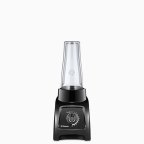 Recon S30
Recon S30  Recon 2-Speed
Recon 2-Speed  Recon 5200
Recon 5200  Recon 5300
Recon 5300  Recon Pro 500
Recon Pro 500 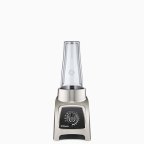 Recon S55
Recon S55  S30
S30  2-Speed
2-Speed 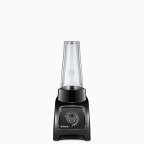 S50
S50  Recon 7500
Recon 7500  5200
5200  S55
S55 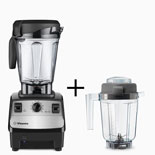 Recon 5300 + 32oz
Recon 5300 + 32oz  Recon Pro 750
Recon Pro 750  7500
7500  Pro 500
Pro 500  Recon 7500 + 32oz
Recon 7500 + 32oz  Pro 750
Pro 750 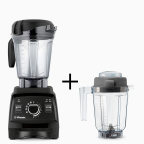 Recon Pro750+32oz
Recon Pro750+32oz  7500 + 32oz
7500 + 32oz  Pro 750 + 32oz
Pro 750 + 32oz  780
780 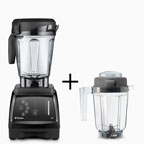 780 + 32oz
780 + 32oz(If you want the 32-oz container, you have to add it to your cart separately: 32-oz container link)
If you’re overwhelmed by the choices and just want to know my preference, I’ve used all of the different types of Vitamix blenders, and before I started using Ascent, the one I used on a daily basis was the 7500, with an extra 32-oz container for blending smaller amounts. (For the best deal, check out certified reconditioned.) All of the models are excellent, and I don’t think there is a wrong choice. (Plus, if you change your mind in the first 30 days, you can get a full refund, including free shipping both ways.)
Summary of Differences
These are the five key decisions to make when deciding which Vitamix to buy:
The following comparison chart shows the relations between the different machines in the S-Series, C-Series, and G-Series. The machines within most boxes of the chart are identical, but they come with different accessories and cookbooks (the exceptions are the S50 and S55, where the S55 has 2 more presets than the S50, and the Pro 750 and Vitamix 780, where the 780 has a flat touchpanel control). Generally the differences in accessories/cookbooks are pretty marginal, so I’d recommend going for the lowest price model within the box.

(“+” indicates there are also more expensive options in addition to the price listed in the chart. The following machines are not shown because they do not fit in with the rest: the Vitamix Turboblend Two Speed and Three Speed lack variable speed control, and the Vitamix 5300 and 6500 are a hybrid of the 6300 and 7500—i.e. they have a 7500 container on a 6300 base, without or with presets.)
Personal Blender? (S-Series vs. C-Series and G-Series)
(Vitamix S30 and S55 vs. 5200, 7500, et al.)
 In 2014 Vitamix released the Vitamix S30. It is smaller than the other Vitamix models, and also comes with a combination blending container/to-go smoothie cup. The Vitamix S50 and Vitamix S55 came out in 2015, and they are the same as the S30 but add preset modes. Since these models are significantly different from all the other models, I put up a detailed Vitamix S30 and S-Series review. If you are considering a smaller blender, or like the idea of blending in a to-go smoothie cup, you should check them out. Not surprisingly, the S-Series’ smaller size means that their maximum capacity is lower the other models (40 oz vs 64 oz).
In 2014 Vitamix released the Vitamix S30. It is smaller than the other Vitamix models, and also comes with a combination blending container/to-go smoothie cup. The Vitamix S50 and Vitamix S55 came out in 2015, and they are the same as the S30 but add preset modes. Since these models are significantly different from all the other models, I put up a detailed Vitamix S30 and S-Series review. If you are considering a smaller blender, or like the idea of blending in a to-go smoothie cup, you should check them out. Not surprisingly, the S-Series’ smaller size means that their maximum capacity is lower the other models (40 oz vs 64 oz).
Variable Speed?
(Vitamix Two Speed vs. 5200 and Vitamix 6000 vs. 6300)
 The variable speed control found on all Vitamix machines except for the Two Speed and 6000 is useful for when you don’t want to fully liquefy your blend. Examples are pesto, salsa, or chopping vegetables. If you don’t have variable speed, you can get away with quickly pulsing, but you won’t have quite as much control. The variable speed also makes the “bubble removal trick” more effective, although pulsing on low speed also works.
The variable speed control found on all Vitamix machines except for the Two Speed and 6000 is useful for when you don’t want to fully liquefy your blend. Examples are pesto, salsa, or chopping vegetables. If you don’t have variable speed, you can get away with quickly pulsing, but you won’t have quite as much control. The variable speed also makes the “bubble removal trick” more effective, although pulsing on low speed also works.
Preset Programs?
(Vitamix Two Speed vs. 6000, Vitamix 5200 vs. 6300, Vitamix Professional Series 200 vs. Professional Series 500, Vitamix S30 vs. S55, and Vitamix Professional Series 300 vs. Professional Series 750)
 The preset programs on the 6000, 6300/Pro 500, S55, and Pro 750 allow you to select a program, turn it on, and then the machine will automatically ramp up the speed and then shut off after a certain amount of time. There are a number of reasons that people appreciate this function:
The preset programs on the 6000, 6300/Pro 500, S55, and Pro 750 allow you to select a program, turn it on, and then the machine will automatically ramp up the speed and then shut off after a certain amount of time. There are a number of reasons that people appreciate this function:
• You can start the machine and “walk away” to do something else.
• If you strictly follow recipes the presets can yield more consistent results.
• Presets can give new users more confidence with the machine.
However, the presets do not work perfectly every time. Sometimes ingredients require tamping to start circulating past the blades, so you can’t always “walk away.” Also, the preset time might not be the optimum blending time if you modify a recipe. You may find that your smoothie is not fully blended after the smoothie program runs, so you have to run it again. A commercial coffee or smoothie shop makes the same recipes over and over, so in that setting presets are extremely useful. If you constantly make new combinations and of differing amounts, as many home users do, the settings may be less useful. It’s not too hard to tell when something is sufficiently blended, and after a few trials anyone should be able to figure it out. For these reasons, I personally would not pay extra for the preset settings. However, I know many people who have the presets love them. One thing to remember is that the machines with presets still have the variable speed knob for full manual control. If you don’t mind the added cost of presets, you can always switch back and forth to manual control.
C-Series vs. G-Series (Next Generation)?
(Vitamix 5200 vs. 7500, and Vitamix Professional Series 500 vs. Professional Series 750)
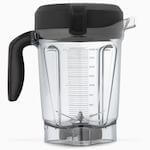 Vitamix released the “Next Generation,” aka “G-Series,” models in 2012. Both the base and the pitcher have an updated design. The base has slightly better sound muffling and also has better airflow which means that it can work harder before it overheats. To go with the better-cooled motor, the updated pitcher has a 4-inch blade instead of the Standard/Classic “C-Series” 3-inch blade. The 4-inch blade is in a shorter and wider container that has the same capacity as the 64-oz C-Series container.
Vitamix released the “Next Generation,” aka “G-Series,” models in 2012. Both the base and the pitcher have an updated design. The base has slightly better sound muffling and also has better airflow which means that it can work harder before it overheats. To go with the better-cooled motor, the updated pitcher has a 4-inch blade instead of the Standard/Classic “C-Series” 3-inch blade. The 4-inch blade is in a shorter and wider container that has the same capacity as the 64-oz C-Series container.
Advantages of the wider design:
• less need for the tamper (ingredients fall into the blades more easily)
• better chopping capability (you can course-chop more ingredients at a time)
• easier to scrape thick mixtures out
Advantage of shorter design:
• easier storage (at 17.5” tall, the container with lid on the base fits under standard kitchen cabinets)
Advantages of the 4-inch blade:
• faster processing time
• under some circumstances, marginally smoother blends
The one disadvantage of the new container is that for small volumes of under ~2 cups it does not work quite as well as the C-Series narrow container. The G-Series wider design causes two things to happen. First, there is more splashing up onto the inside of the lid and upper walls of the container, which means you lose a small amount of your blend unless you carefully scrape off the lid and walls. Second, you need slightly more volume to cover the blades and get good circulation going. The minimum volume to blend depends on what you are blending, and also on how much effort you are willing to spend pushing ingredients back into the blades. For example, for best results, the narrow containers can make nut butter easily by starting with 3 cups of nuts, whereas the wider Next Generation containers do best with 4 cups of nuts. For easier, more liquidy, blends, you can go below 1 cup in either container, but Next Generation containers will splash around more.
This disadvantage is a non-issue if most of your blends are over 2 cups, or if you are willing to spend a bit more to buy an additional narrow container, which will give you the best of both worlds. I like the 32-oz container for this purpose, although the 48-oz container has the same narrow bottom so it works just as well. The 48-oz container is just a bit bulkier on the outside because it sits outside the centering posts instead of inside of them, and its top is wider as well.
(The narrow C-Series Vitamix containers are compatible with G-Series models, but the G-Series containers are not recommended for use on C-Series models. The longer G-Series blades increase the load, and Vitamix does not recommend the C-Series cooling system for those increased loads.)
Reconditioned?
 Buying reconditioned is a great way to save money. For more details on deciding about buying reconditioned, see my refurbished Vitamix page.
Buying reconditioned is a great way to save money. For more details on deciding about buying reconditioned, see my refurbished Vitamix page.
Continue on for more details of each model type…
The array of different Vitamix blenders is a bit confusing, but it turns out that there is a lot of redundancy between the different models. I am only discussing models made for consumer/home use. Their commercial blenders are not ideal for home use because they are generally more expensive and have shorter warranties (3 years vs 7 years for home use; they are warrantied for constant use—think of how many times per day a blender at Jamba Juice runs compared to at your home).
The Vitamix website currently lists over 30 different home models, but they are all variants of three main designs: “personal” (S-Series), “standard/classic” (C-Series), and “next generation” (G-Series). For each of these main designs there are a few different options, to make a total of 8 different machine types. The rest of the models have identical bases, but come with different containers and/or accessories.
S-Series Motors
If the smaller size, dishwasher safe container, and “to-go” blending container appeal to you, please read the full details at my Vitamix S30, S50, and S55 review. For quick reference, the size of the base is 8.3″ deep x 5.9″ wide x 7.7″ tall. With the 20-oz to-go container the total height is 14.55″. The height is 15.66″ with the 40-oz container. These models have lower power, but they are still capable of making all of the usual Vitamix creations, just in smaller quantities.
C-Series Motors (Standard/Classic)
There are three types of bases of the standard variety. The differences are in the controls. The dimensions of the base of these machines are 8.75″ deep x 7.25″ wide x 8.25″ tall. There are three different container size options: 32 oz, 48 oz, and 64 oz, which result in height of base plus container/lid of 16.9″, 17.4″, and 20.5″ respectively.
Standard, no-variable speed (Vitamix TurboBlend Two Speed and Three Speed)
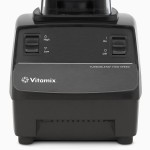 TurboBlend Two Speed (
TurboBlend Two Speed ($399$349); reconditioned for $299. This machine comes with a 5-year warranty and lacks the variable speed knob. Variable speed is useful for cases where you want to have finer control over the texture (i.e. if you don’t want a totally smooth purée). However, you can accomplish some non-liquefying chopping tasks by quickly pulsing the machine. While this is the most affordable new machine, I’d highly recommend looking at the reconditioned 5200, which has the same warranty and adds variable speed for $70 less.
In May 2016 Vitamix came out with a new no-variable speed machine, the TurboBlend Three Speed($499). It is exactly what it sounds like: it has three speed settings: low, medium, and high. It also has a pulse switch, which does the same thing as switching the start-stop button on and off. The pricing on this model is a bit strange, since for $50 less you can get a machine with fully variable speed. Plus, the TurboBlend 3-Speed comes with a 5-year warranty, instead of the 7 years on machines like the 5200.
Standard variable speed (Vitamix 5200 et al.)
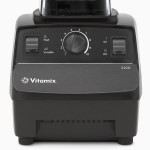 Until recently this was Vitamix’s bread and butter, and they have a lot of models to show for it: 5200 ($449), TurboBlend VS (retired), CIA Pro (retired), Pro 200 ($499), Creations II ($449), and Creations GC (retired); reconditioned for $329. These machines are essentially identical. Some are available with a shorter 48-oz container instead of the 64-oz container. The smaller container is nice because it’s more compact (and fits under standard kitchen cabinets), but of course its capacity is lower. The aesthetics of the switches and dial are slightly different between the different models. The Creations models come with a 5-year warranty, while the rest are 7 years. The 5200 comes with their “whole foods cookbook,” the TurboBlend VS comes with a vegetarian/vegan/raw cookbook and a nutmilk straining bag, the Pro models come with a cookbook with restaurant-oriented recipes (the CIA one—that’s Culinary Institute of America—comes with an additional recipe book). Note that if you buy reconditioned, you cannot choose which of the Standard models you are getting; Vitamix will choose for you based on availability, but remember that functionally they are identical.
Until recently this was Vitamix’s bread and butter, and they have a lot of models to show for it: 5200 ($449), TurboBlend VS (retired), CIA Pro (retired), Pro 200 ($499), Creations II ($449), and Creations GC (retired); reconditioned for $329. These machines are essentially identical. Some are available with a shorter 48-oz container instead of the 64-oz container. The smaller container is nice because it’s more compact (and fits under standard kitchen cabinets), but of course its capacity is lower. The aesthetics of the switches and dial are slightly different between the different models. The Creations models come with a 5-year warranty, while the rest are 7 years. The 5200 comes with their “whole foods cookbook,” the TurboBlend VS comes with a vegetarian/vegan/raw cookbook and a nutmilk straining bag, the Pro models come with a cookbook with restaurant-oriented recipes (the CIA one—that’s Culinary Institute of America—comes with an additional recipe book). Note that if you buy reconditioned, you cannot choose which of the Standard models you are getting; Vitamix will choose for you based on availability, but remember that functionally they are identical.
Sometimes these models are listed with their color-specific SKU. All of the following models are identical to the 5200, they just come with different colors and names: Vitamix 1709, 1363, 1364, 1365, 1709, 1723, 1732. They also sometimes go by VM0103. Vitamix 1978 is also the same, but comes with a 48-oz container.
Standard variable speed + presets (Vitamix 6300 and Professional Series 500)
 Pro 500 ($559) and 6300 (retired); reconditioned for $379. These are the same model; the only difference is that the 6300 comes with the “Savor” cookbook, which has a broader range of recipes than the Pro 500’s “Create” cookbook, which focuses more on restaurant-style recipes that tend to be richer.) They have 3 preset programs that run the blender for a certain amount of time and speed for smoothies, frozen desserts, and hot soups. Their switches are slightly different from the non-preset models. The non-preset models have an on-off switch, a variable speed knob, and a high-variable speed switch. The preset ones have moved the highest speed setting onto the knob and replaced the high-variable speed switch with a pulse switch. This is really a minor aesthetic difference, since you can achieve pulsing on the non-preset models by quickly flicking the on-off switch on and off.
Pro 500 ($559) and 6300 (retired); reconditioned for $379. These are the same model; the only difference is that the 6300 comes with the “Savor” cookbook, which has a broader range of recipes than the Pro 500’s “Create” cookbook, which focuses more on restaurant-style recipes that tend to be richer.) They have 3 preset programs that run the blender for a certain amount of time and speed for smoothies, frozen desserts, and hot soups. Their switches are slightly different from the non-preset models. The non-preset models have an on-off switch, a variable speed knob, and a high-variable speed switch. The preset ones have moved the highest speed setting onto the knob and replaced the high-variable speed switch with a pulse switch. This is really a minor aesthetic difference, since you can achieve pulsing on the non-preset models by quickly flicking the on-off switch on and off.
Some people love the presets because you can set it and walk away (assuming the mixture is circulating and you don’t need the tamper), and because they get more consistent results. However, the more consistent results will only hold if you always add the same quantities and types of items to the blender. For example, if you’re making a small smoothie, you can blend it for less time than if you were making a large one. One other thing is that you can set the non-preset machines and walk away—you just have to come back to stop them. I often use the blending time to rinse off the knife and cutting board that I used. You’re not likely to forget that the Vitamix is running because it’s loud enough to hear throughout the house. The variable speed knob goes to the same high speed as the previous models on high, but it’s lowest setting is a bit faster than on the 5200 et al., so you lose a tiny bit of fine control. Whether the presets are worth it is a personal question—I wouldn’t pay extra for them, but some people love them.
Standard no variable speed + presets (Vitamix 6000)
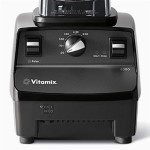 6000 (retired). Released October 2013, this is more of a mash-up of existing machines than a truly new one. It’s a sort of blend between the Two Speed, and the 6300. It does not have variable speed control, but it has six preset timed blending settings. These settings will automatically ramp up the speed, and then turn it off after a specified time of 20 sec, 30 sec, 1 min, 1.5 min, 4.5 min, or 6.5 min. Like the 6300, the pulse control is spring-loaded so that it only stays on as long as you hold it down, and it blends at a medium-low speed.
6000 (retired). Released October 2013, this is more of a mash-up of existing machines than a truly new one. It’s a sort of blend between the Two Speed, and the 6300. It does not have variable speed control, but it has six preset timed blending settings. These settings will automatically ramp up the speed, and then turn it off after a specified time of 20 sec, 30 sec, 1 min, 1.5 min, 4.5 min, or 6.5 min. Like the 6300, the pulse control is spring-loaded so that it only stays on as long as you hold it down, and it blends at a medium-low speed.
G-Series Motors (Next Generation)
In 2012 Vitamix released a new generation G-Series base with improved airflow that makes it run cooler and quieter than the classic C-Series one. With the improved cooling, the G-Series base can use a new pitcher design that is wider and has longer blades. This design makes the tamper less necessary, and makes it easier to get thick mixtures out. The longer blades also process food faster and work better for chopping. The G-Series machines are compatible with the C-Series containers, so if you want to use the dry blade you can use the same classic dry container. Dimensions are 9.4″ deep x 7.7″ wide x 17.5″ tall (with new-style 64-oz container in place). For more details of sizes, check out the PDF footprints I made for my Vitamix S30 review.
Next generation motor (Vitamix 7500, Professional Series 300, and Creations Elite)
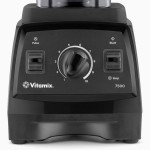 7500 ($529), Creations Elite ($557.50), and Pro 300 ($559); reconditioned for $439. These are all the same machine, so don’t worry about the note on the Reconditioned Next Gen page that says that the label may reflect any of these models. The only difference is the name printed on it. One point of confusion is that the Creations Elite is sold new with a smaller container, but if you happen to get sent a Creations Elite as a Reconditioned Next Gen, it will come with the same low profile 64-oz container that the 7500 comes with.
7500 ($529), Creations Elite ($557.50), and Pro 300 ($559); reconditioned for $439. These are all the same machine, so don’t worry about the note on the Reconditioned Next Gen page that says that the label may reflect any of these models. The only difference is the name printed on it. One point of confusion is that the Creations Elite is sold new with a smaller container, but if you happen to get sent a Creations Elite as a Reconditioned Next Gen, it will come with the same low profile 64-oz container that the 7500 comes with.
Next generation motor + presets (Vitamix Professional Series 750 and Vitamix 780)
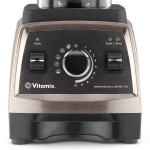
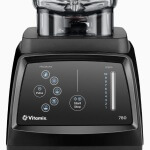 Pro 750 ($599–$649), 780 ($719); available reconditioned: 750 for
Pro 750 ($599–$649), 780 ($719); available reconditioned: 750 for $519–$569$499, and 780 for $519$399. These models have 5 presets: smoothies, frozen desserts, purées, hot soups, and self-washing. If you want to see more details of exactly what the presets do, check out my page about demystifying Vitamix presets. The 780 is identical, except that it has a touchpanel control interface. See my Vitamix 780 review for more details.
Vitamix Heritage 750 vs. Original 750?
In late 2015, Vitamix released a new version of the Pro 750: the Heritage line. The Vitamix Heritage 750 is functionally equivalent to the original Pro 750, but it has two differences on the exterior of the base. The upper shell (see diagram below) is now metal on the Heritage models. The Vitamix website doesn’t put Heritage in the model title, but it’s there in the description.
 The original 750 came in a brushed stainless finish option, but the upper shell was plastic with a thin metallic coat that could be scratched or scuffed. (When I tested the original 750 for a couple of months, I did not see any problems, but I have heard that some people have noticed scratches/scuffs.) The solid metal of the new Heritage models is more durable. Also, the metal shell muffles the the motor a bit more than the plastic, making the Heritage models a bit quieter.
The original 750 came in a brushed stainless finish option, but the upper shell was plastic with a thin metallic coat that could be scratched or scuffed. (When I tested the original 750 for a couple of months, I did not see any problems, but I have heard that some people have noticed scratches/scuffs.) The solid metal of the new Heritage models is more durable. Also, the metal shell muffles the the motor a bit more than the plastic, making the Heritage models a bit quieter.
 The other minor difference is that the Heritage models’ front panel has fewer backlights: Heritage models light up the indicators above the pulse and start-stop switches, whereas the original Pro 750 has backlights around the central knob as well.
The other minor difference is that the Heritage models’ front panel has fewer backlights: Heritage models light up the indicators above the pulse and start-stop switches, whereas the original Pro 750 has backlights around the central knob as well.
The Heritage metal is available in brushed stainless and copper finishes. (Currently on Vitamix.com, the Heritage options are listed on the main Pro 750 page, and the old brushed stainless finish is discontinued.)
I believe it is called Heritage because it is a throwback to the original Vitamix models that had all-metal bases. The plastic that Vitamix has been using for their bases for the past 25 years is extremely durable, so this change won’t affect functional longevity. That said, the elegant finish of the Heritage models will now likely stay unblemished for longer. It’s also nice that Vitamix did not increase the price for this upgrade.
The Vitamix 5300 and 6500
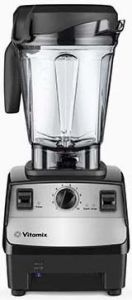 5300 ($529) and 6500 ($599); reconditioned for $360. Vitamix does not currently sell the new models online, only the reconditioned one. These are “new” models for 2015, although they are actually just slightly unexpected mash-ups of previous models. They are a hybrid between a 6300 and a 7500. They use the wide Next Gen (G-Series) container but they have a Classic (C-Series) base. The 5300 has variable speed and a pulse control switch, and has no presets. Meanwhile, the 6500 has the same three presets as the 6300. (Further evidence of equivalence between the 5300/6500 and C-Series models is on the Reconditioned C-Series 6300/Pro 500 page: it says its base may be a 6500.)
5300 ($529) and 6500 ($599); reconditioned for $360. Vitamix does not currently sell the new models online, only the reconditioned one. These are “new” models for 2015, although they are actually just slightly unexpected mash-ups of previous models. They are a hybrid between a 6300 and a 7500. They use the wide Next Gen (G-Series) container but they have a Classic (C-Series) base. The 5300 has variable speed and a pulse control switch, and has no presets. Meanwhile, the 6500 has the same three presets as the 6300. (Further evidence of equivalence between the 5300/6500 and C-Series models is on the Reconditioned C-Series 6300/Pro 500 page: it says its base may be a 6500.)
The reconditioned 5300 is the most affordable option for a machine with the short/wide container.
The strange thing about these models is that previously Vitamix stated that Next Gen containers should not be used on Classic bases because they do not have the updated airflow design that cools the motor more effectively.
I strongly suspect that the 5300 has the same microprocessor speed control as the 7500, Pro 750, and 6300, just without the presets. (You can read about the speed control of the different machines on my Vitamix RPM measurement page.) The microprocessor speed control should help protect the motor when using the wide container at high loads and very low speeds, but at maximum speed it shouldn’t make a difference. The marketing copy for the 5300 says that it comes “with a faster, yet quieter, motor,” but I am skeptical of those claims [Update: interestingly, Vitamix removed that phrase].
The 5300 and 6500 are a bit louder than the G-Series bases, which have sound-dampening technology not present in the C-Series bases. At the same price point, I would prefer the 7500.
Satisfaction Guarantee
Vitamix has a 30-day satisfaction guarantee, so if you have second thoughts you can return a machine within the first 30 days for a full refund and they even pay return shipping.
Warranty
If your machine has any problems during the warranty period of 5 or 7 years, Vitamix will repair or replace it, and they cover shipping costs both ways. For more details about warranties, check out my Vitamix Warranty page.
Reconditioned Vitamix
 I know I already mentioned reconditioned machines, but I want to restate what a great deal I think they are. These factory-refurbished machines offer the best prices you’ll find on Vitamix: 5200 for $329, Pro 500 for $379, and 7500 for $439. For more details, see my refurbished Vitamix page.
I know I already mentioned reconditioned machines, but I want to restate what a great deal I think they are. These factory-refurbished machines offer the best prices you’ll find on Vitamix: 5200 for $329, Pro 500 for $379, and 7500 for $439. For more details, see my refurbished Vitamix page.
Payment Plans
Want to start blending right away, but don’t want to pay the full price up front? Vitamix offers payment plans with zero interest and no fees if you make payments on time. For more information, check out my payment plan page.
Free Shipping
Clicking on any Vitamix link on this page will automatically apply a promotion code, which gives you free shipping on your order of a Vitamix machine (or anything else on Vitamix.com over $50) in the U.S. or Canada. For more details, see my page about the Vitamix promotion code.
Extra Bonus
If you order via a link on this site, Joy of Blending can get a commission. I deeply appreciate your support, and, to thank you, I want to help you get the most out of your new machine. I try to answer all questions from everyone, but sometimes I get swamped. If you order through one of my links, I will give you a private way to contact me so that I can answer your questions before visitors who are not on the special list. Please make sure my link is the last link you click before placing your Vitamix.com order. Then just forward your order confirmation to thanks@joyofblending.com.
Recommended Accessory
I highly recommend a spatula for getting the last bits of thick mixtures out of the container. For the narrow containers I recommend a long narrow spatula. For the wide containers, I recommend Vitamix’s under-blade scraper.
Dry Container
If you’re wondering if you should get a dry container, this new post is for you: Is the dry container worth it?
Phew… so that completes the Vitamix model round-up. I’m looking forward to getting back to describing some actual recipes!
Or follow along on Twitter or Facebook:

H,
So I received my vitamix and have made a few smoothies. I made one with frozen raspberries and was surprised to find that there were still seeds in the drink. I had read that with the vitamix there were no seeds left at all. I followed the instructions to the letter and set it on the specified preset button. When I still had seeds I did another 10 seconds on high.
So my question is…. is it normal to have seeds in the smoothie and unrealistic to expect no seeds at all?
Just want to make sure my machine is ok.
Thanks,
Linda
Raspberry seeds (and to a greater extent, Blackberry seeds) are hard enough that it’s normal to not have them totally disappear into a smoothie. When I use raspberries there’s usually a detectable slight grittiness.
There is one trick I’ve heard of that I haven’t tried myself yet, but I’ve been meaning to experiment with it. You can put the raspberries in first, along with a little water (or ice if the raspberries are not frozen). Then run them by themselves for maybe 30 seconds. That should get the seeds maximally broken down.
Hi
I’m in the market to buy a vitamix but was wondering which model would be best for me. Relearning to swallow due to oral cancer and radiation, I presently can eat pureed baby food and want to make my own and need to know which machine will do the best job
thanks
Jeff
All of the Vitamix machines will puree equally well, the differences mainly come down to convenience and personal preference.
You’d do fine with a Standard 5200, but you might opt for a Next Generation model if you wanted to not need to use the tamper quite as much. Some people find the machines with presets more convenient, but whether they are worth it is a personal question.
Best wishes for your recovery.
Hi Jeff,
Good luck with your recovery. I went thru the same stuff but in my throat, so 16 radiation points per day, 5 days a week for 8 weeks. I am good to go now. Gracias a Dios.
I have the Pro 300 and love it. I make an antioxidant breakfast smoothie each day and it blends things so completely, as compared to my perfectly good Oster. I grind certain seeds and grains and the Pro 300 turns them into powder easily.
If you want to puree things, it does the job. Keep it on long enough on high speed and it evens heats them up.
Best of luck with your recovery. Thank God and keep the faith.
I bought a reconditioned one after lots of research & thanks to this website(!) It was the $329 one ($352.03 after tax). I ended up with the CIA Professional Series. Looks brand new! I had a Ninja & this machine is 1000 times better & worth the money in my opinion. I make smoothies in the morning with oatmeal, chia seeds & flax seeds along with fruit. The Ninja could never break up the oatmeal & seeds. The VM pulverizes them & it comes out smooth like pudding! I am so happy with my purchase & strongly recommend the reconditioned models.
So it’s been a few months since I’ve had my VM. A reconditioned is definitely the best deal out there (not Costco, QVC, Whole Foods or BBB) if cost is a concern for you. I ended up with a CIA $299. Use it daily for breakfast smoothies. First thing that goes in is oatmeal. It turns it into powder. Then flax, fruit, Amazing Grass Green super foods & almond milk. I also make batches of soups. My husband loves to make PB, banana, cocoa powder almond milkshakes a few times a week. Kale, celery, apples & nut butters -I wasn’t able to get the smooth consistency in the Ninja the way the VM does. Don’t be fooled by consumer reports like I was.
I live in Uk – would the USA 750 work with the UK different voltage, etc?
Thank you
You would need a transformer to convert the voltage. It would have to be a very heavy duty one because Vitamix machines draw a lot of power. I do not have experience with any specific transformers, so unfortunately I can’t recommend one.
Also, last I heard from Vitamix, using a transformer will void the warranty, because sometimes transformers fail and can damage the machine. Vitamix also seems to like to keep distribution separate for different countries, and I think it may be partially due to wanting to provide better local service.
Hi Adam,
Thanks to your help, I was able to purchase a reconditioned 7500 a couple of months ago. I have come to realize that I am going to need a smaller-sized wet container than the 64 oz. wide one which came with this model, as I often find myself making small batches of salad dressing, pesto, etc. I was all set to order a 32 oz. container until I read one reviewer’s comment on the Vitamix website that this sized container does not come with a tamper, whereas the 48 oz. sized container does. Do you happen to know if that is a true statement and if so, do you think it matters whether or not I get a tamper along with the 32 oz. wet container? Many thanks in advance for any light you can shine on this subject!
As far as I know, that reviewer is correct: for whatever reason Vitamix is including the mini-tamper with the 48-oz container but not the 32-oz one. I would say that it would be nice to have the tamper. You likely wouldn’t need it for liquidy things like salad dressing, but it may come in handy for things like pesto.
However, I wouldn’t let that be the deciding factor between those two containers, because you can get the mini-tamper separately for only $10, which is the price difference between the 32-oz and 48-oz containers. Since you already have a 64-oz container, I think the smaller 32-oz container is a better choice.
One side note for others: if you have a Standard-style machine (5200, etc.) your tamper is likely compatible with the 32-oz and 48-oz containers. You’ll see that it has a step change in its width, that stops at the smaller opening of the shorter containers. (If you have a really old style tamper, it might not have this step, so double check first.) Note that this tamper is not compatible with the wide Next Generation 64-oz container.
hello im thinking of getting this model from QVC Vitamix Creations II 48 oz. 12-in-1 Variable Speed Blender.
Is this a good Vitamix to purchase?
That is a perfectly good model, but you can save $70 by buying it reconditioned from Vitamix. The QVC models have 5-year warranties, and reconditioned machines have 5-year warranties. The reconditioned machines that I’ve seen have mostly been indistinguishable from new ones. (The few ones that I could tell weren’t brand new had a few scuffs on the rubber pad that the pitcher sits on—totally invisible when the pitcher is there, and it will naturally get scuffed with use.)
That machine is the same as the Standard models on the Vitamix site, except that it comes with the 48-oz container instead of the 64-oz container.
If you want that machine with the 48-oz container, the way to order it reconditioned is on the phone. Call up Brenda at 800-848-2649 Ext. 2305, and for free shipping mention my code: 06-007021.
Very informative article. I referenced it many times. One comment about the reconditioned models. You said the container is new. Yes, the glass part of the container is new but the blade is not … got this info directly from http://www.vitamix.com.
Right, the blade is not guaranteed to be new. What I referred to as the container, Vitamix calls the “container shell,” it’s not glass BTW, it’s copolyester. Guaranteed new are the container shell, lid, tamper, cookbooks, and DVD—basically the parts that are most likely to get slightly scratched or marked up. Note that the blade is removed and sterilized, and if it shows any sign of wear it is replaced.
Just wanted to beat a dead horse. Had a blendtec and it made a grinding sound when it starts up so I returned it. Bought the 6300 at Costco, and after reading you blog, realize e salesman made a few false statements. Trying to decide between the 6300 and the 7500. I like the newer quieter motor and think I should get the newest technology in stead of 6 year old tech, as well as the 4 inch blade but dont want more froth. On the 6300 Kinda like the presets because I mostly make green smoothies. Haven’t even open the 6300 because of my dilemma but need to decide cause I can’t go long with out it. Just lookin for help pulling the trigger. Thanks for all the great info.
I’d say the top reason to get the 7500 would be the wider container and longer blades because it makes blending some things easier.
In practical use the difference in sound at maximum speed is very minimal. I haven’t seen a difference in frothiness.
Personally, I wouldn’t worry about losing the presets. As you come up with your own recipes, preferred amounts, and preferred degree of blending, you would probably end up tweaking the blending times, so the presets become less useful. That said, some people love them, and having them doesn’t take away from being able to fully control the machine–it’ll just cost a bit more up front.
Hello! I just got my reconditioned one today! Super excited. We had borrowed my parents Pro 200 for a couple of weeks as a trial run. Loved it. My mom originally bought the under the counter model and returned it for the Pro 200. The force of the motor was blasting everything up into the lid which made a pain to clean up, plus you’re losing part of your smoothie. The taller carafe is better. We decided to order the model with the 3 presets, figuring it will save me time in the morning when I’m trying to get the kids and hubby out the door. When I opened the box it actually isn’t a Pro 500 or 6300! It is the “Total Nutrition Center 3″……which according to the Vitamix website under manuals lists this model as(Canada). Interesting! Here’s to good health!
I forgot to mention that it was manufactured in July 2013! Practically new!
I love my 7500. I did have a question about smoothies. Most recipes I see use almond or soy milk, or juice or even yogurt. Very few use regular milk, which is what I have on hand. Is there a reason for that?
Just chipping in my two cents on this one. When I make drinks in my Vitamix, 99% of the time I don’t use any of the above. I just put in whatever fruits I want (usually cut into chunks or at least cut in half or quarters or whatever seems reasonable), some water, and some ice cubes. The only exception I’ve made to that so far is a peanut butter/frozen banana thing, and in that I use milk and ice cubes. I don’t like store-bought juice much, like but don’t typically buy almond or soy milk, and the organic yogurt I buy is precious (i.e. too expensive to buy a lot of) so I prefer to enjoy it as a standalone thing. So for me, water or regular milk work great. Sometimes in cooking it’s vital to follow rules and recipes, but I think it’s good to go a little crazy with Vitamix drinks! 🙂
With your new Vitamix you can easily make your own tasty almond milk. It is fast and easy and cheaper than buying Blue Diamond Almond Breeze or Silk Pure Almond at the store.
Soak one cup of unsalted almonds, and a broken up cinnamon stick in a quart of water overnight.
Using the same water, pour everything into the Vitamix.
Add 1 tablespoon of Agave syrup or Agave nectar and 1 teaspoon of vanilla extract. I have also tried honey and jarabe natural but the Agave is just right.
Blend on high speed for one and a half minutes. The Vitamix should completely pulverize the almonds. If not, let it settle and blend for another 30 seconds.
Keep refrigerated.
There is a fair amount of overlap between people who avoid milk and people with Vitamixes (especially the people who write smoothie recipes). They’re generally avoiding milk because they can’t digest it or because they’re avoiding animal products. However, there’s no reason why you can’t put cow milk into your smoothie instead of soy milk.
Personally, I often add nuts or chia seeds and water.
The Canadian website lists a Vitamix Total Nutrition Center. Would this be a 5200 Vitamix?
Yes, that’s right. I’ve still been meaning to add a page about the names of machines outside the US. In the meantime:
Total Nutrition Center = 5200
Aspire = Creations II (same as 5200, except w/ 5-year warranty instead of 7)
Total Nutrition Center 3 = 6300/Pro 500
We just got the reconditioned 3 pre set model. It came with the label Total Nutrition Center 3. We’re not in Canada, close…Buffalo, NY. Until I looked it up I wasn’t even aware of that label. We love it!
Dear Adam,
Thank you for your exhaustive research. I had attempted to read this entire blog before pulling the trigger myself so as to not feel the need to post on here and have you respond. But it is a lot of money – although it is also an investment I am committed to making – and I don’t want to take that much of your or anyone else’s time. I am on the verge of buying hopefully my first and last Vitamix!
So, from all that I have gathered thus far, this is what I have come up with and I would just love your opinion, Adam, as to whether it seems like I’ve got it right and am making the best choice all at once.
Money is not really an issue with this product for the reasons stated above, but I love good deals and would love to save where I can. Without further ado, here’s what’s in my basket / cart:
Red Reconditioned 7500, The three spatulas, Filtration bag, Live Fresh recipe book & The 32oz dry grains container. Does all that seems silly? I have read the post on the “Is the dry grains container worth it” and I believe it is. But could I just as easily get the regular 32oz container and dedicate that as my dry grains container and forgo the Whole Grains Cookbook, or do you think that cookbook is worth it? And if not, then should I just opt for a larger dedicated dry grains container like the 48oz for even less, or the 64oz for just a little more?
Sorry if I went on too long, just want to do this right the first time and be done with it. I, and I think everyone who has visited this blog & commented or not, thank you, Adam, for your time and attention to detail and the smallest silliest questions, ideas, comments, etc., now including my own I regret to admit.
Thank you, thank you, thank you (in advance, for me),
gabo
I understand wanting to get things right for this big one-time investment. It looks like you’ve got a reasonable plan.
Regarding the dry grains container: it comes down to what you’ll primarily be using it for. As I showed in the dry container post, you *can* use a wet blade for dry ingredients, but if you are getting a dedicated container and are going to grind a lot of dry ingredients you’d likely be better off with the dry blade. Without knowing what you’ll be making, I can’t say what’s best, but it sounds like you’re significantly interested in dry grinding, so I would say go for the dry container.
Hi Adam — thanks so much for your website. It was incredibly helpful in making the decision to purchase a refurb 7500. I used your link. 🙂
I apologize in advance if this question has already been answered, but the comment section on this page is a little daunting (though I tried to read as much as I could). The recipes on the Vitamix website are for the 5200 — the refurb 7500 has the same size container, so I imagine quantities would be the same, but I don’t know about speed/processor size. Are the recipes for the 5200 equivalent to the 7500?
And how about the ones on your website?
Thank you!
Yes, I know, too many comments to read all of them. I’ve got to make a FAQ!
This is a good question, and really deserves a whole post. It’s strange that Vitamix hasn’t issued any guidance on converting recipes. I haven’t done enough testing myself to come up with detailed guidelines yet, but the general rule is that the 7500 will process things slightly faster, so you blend for slightly less time. The low speeds on the 7500 are also slightly faster than on the 5200, so you would generally select a slightly lower variable speed. Here’s a rough guess: subtract 2 from the variable speeds, and shave off 20% of the processing time.
Most of the things I make I just blend on high until it’s smooth (after ramping up the speed gradually to get things circulating).
That’s a very helpful answer. Thank you so much!
I forgot to also say that the minimum amount to blend easily is slightly more in the wider containers. For example, with peanut butter Vitamix recommends using 3 cups of nuts in the narrow containers, and 4 cups in the wide ones. You can go a bit below that, but it will start to get more tedious, since it is harder to get it circulating.
Hi! Thanks for all of the great info! I just actually cancelled my order for the 6000 from QVC and got the Pro 750 with your promo code. FYI… it was only $519!
Awesome! The $519 reconditioned Pro 750 is usually not available, so that’s why I listed the price at $569 on this page…
I’ve been looking at that for the last several days, and think it may be incorrect. While the 750 comes up at 519, the black and red aren’t available and the price increases to 569 when the stainless is selected. It’s not that hard to miss. Did yours check out at $519?
I went with a Professional 300, though. Even at the reduced price, I couldn’t see spending an extra 20% just to get the automatic settings. I wanted to (shiny, shiny), but decided that the 300 was a better value for me.
Adam, kudos for a great blog.
I’m probably just missing it, but where on the Vitamix website are the height specs for each blender? I need to make sure the one I buy will fit beneath our kitchen counter!
I actually have them on this page at the end of the introduction to each motor type. Or search this page for “dimensions.”
Adam, thanks SO much for all of your insightful info! I think I’ve been reading and bouncing back and forth between here, qvc, target and vitamix sites for 3 days now…and I’m still not sure which one to purchase. I want one of the new refurb models, but I’m thinking of the smaller size smoothies I will be making. Is the better blending “2 cup thing” for the new 64oz containers meaning 2 cups of everything, or 2 cups of liquid?
Also, I see that the refurb 7500 could be a Creations Elite. Is that model a New Generation? Do you think it would come with a 48oz or a wide 64oz?
Thanks!
Karin
The “2 cup thing” may have been overstated. And it’s not a strict cutoff—it’s just that as you get down below 2 cups, the narrower container may make it easier to blend. When we say 2 cups, we’re generally referring to the final blended volume. So, that could be 2 cups of liquid, or it could have started as ~4 cups of loosely packed produce.
I have made 2-cup (final volume) smoothies in the wide container, and it’s perfectly doable. For smoothies the biggest difference is that more of it will splash up onto the sides and inside of the lid.
You are right that the refurb Next Gen they send you could be a Creations Elite, but if it is, they will still give you the wide 64-oz container.
Hi Adam!
After alot of comparing, a couple of Costco demos, and information overload, I finally decided on a Reconditioned 6300 (using your code!). It arrived today, and it’s a gorgeous Red color that fits under my counter if the lid is off! No indication at all that it was reconditioned and I can’t wait to make my green smoothie tomorrow morning. This morning I was telling my husband how much I’m looking forward to not chewing (kale) smoothies made with the Magic Bullet anymore! Thanks again for all your helpful information 🙂
Hi Adam, First I want to thank you for all the helpful information – I actually did read it all! We bought the 5200 stainless steel at the fair with the 64 oz, 48 oz, and 32 oz dry container before reading your website. Then I started researching to make sure we had make the right purchase for our needs. We have 2 more days to make any exchanges should we decide to do so. My first question is about the smaller wet container. When we purchased the 48 oz container it was presented to us as the smaller container which would be easier to get smaller amounts and thicker food products out of such as ice cream, hummus, and nut butters. Now I have been reading more about the 32 oz container as being the smaller container. As the 48 oz widens as it goes up more than the 32 oz does, would that make the vortex not quite as good in the 48oz vs the 32 oz? In other words, will the 32 oz blend a bit better for smaller amounts? Also, can you blend a full 24 or 32 oz in the 32 oz container without it flying up into the lid? Or how much can you blend in the 32 oz container before it would be an amount that it would fly up into the lid and you’d be better off using the 64 oz container? And what about the 48 oz container (same questions)? I’m leaning towards swapping the 48 oz for the 32 oz and haven’t used it yet. Although on the flip side, because it does widen more as you go up, can you get thick mixtures out of the 48 oz easier than the 32 oz? I’ve also debated on whether we want to keep the 5200 or get the 6300 for the presets or even the 7500 or 750 for the wider 64 oz container. Roadshow rep at Costco presented that the 6300 has like an intuitive motor that will speed up and slow down based on what’s needed for what’s being blended and that not having presets is much more complicated and takes a while to learn especially for things like ice cream where you can easily over-blend and get a smoothie instead. When I asked if the 6300 came in stainless steel he said no, but that vitamix made the platinum color as a replacement for stainless steel as stainless steel gets all spotted up and looks bad after a while. When I asked about the 7500 and 750 he said they were not needed for home use and were more for commercial use. I knew he was wrong and and using those machines for commercial use would void the warranty, but I chose not to argue with him about it. It just made me know I couldn’t trust him on his claims or to answer any of my questions as everything he said was geared towards selling the 6300 even if it meant being less than honest. He presented it as the newest, latest, and greatest vitamix machine out. Is that even true? So, a question I still have is this – if we were to trade in our 5200 and get the 7500 or 750 instead and were to use either the 32 or 48 oz (whichever one we end up deciding to go with) for blending a smaller amount (say 2 cups or less), would that be less powerful blending than using the 5200 because the RPM’s would be quite a bit less as those machines are optimized to work with the 4 inch blade as is on the shorter 64 oz as opposed to the 3 inch blade? Because of this I’m thinking to probably stay with the older style if my thinking is correct. So what are your thoughts on this and the other points I’ve brought up? Sorry for so many questions, but we need to decide by this Friday (2 days) what we want to do, and this is a big purchase! Plus your answers will no doubt help others as your answers to others questions have helped me. If anyone else also has answers to any of my questions I would really appreciate the input! Thank you so much!
Wow, epic set of questions! I think you may have set a new record in comment length. FAQ is coming soon so that this information will be easier to process.
For clarity I rephrased and numbered your questions:
1) Does increased width of 48-oz container (compared to 32-oz) negatively affect the vortex and blending quality? In my experience, no. The important thing is that the part near the blades is the same width.
2) What is the maximum volume for blending in the 32-oz and 48-oz containers? You can blend to capacity, plus a little extra if you’re careful about spilling. I’ve blended 40 oz in the 32-oz container before, although ideally it’s best to stick to the rated capacity to minimize chances of spilling.
3) Is it easier to get thick mixtures out of the 48-oz container because it is wider? Very slightly, but not enough that I would give it much weight.
Note: If you already have a 64-oz container, I’d favor the 32-oz container over the 48-oz because it has less bulk, which makes it just a bit handier (it sits inside of the centering posts, instead of going around them—look at a picture if that isn’t clear). If you’re blending more than 4 cups, I’d say you might as well use the big container.
4) Costco rep says the 6300’s motor is “intuitive.” Is it? This is a bit of a stretch. I’ve done tests on that motor
that I will publish soonthat demonstrate the kernel of truth in his statement, but for the time being the main takeaway is that the presets are essentially timed programs.5) Is it hard for a beginner to blend things like ice cream without presets? I don’t think so. You might overshoot the first time you do it if you’re not careful, but I think it’s easy to figure out.
6) Is the 6300 the latest and greatest model? No. The latest model is the 6000, and the “greatest” model is 750.
7 ) Does a narrow container on a Next Generation machine yield inferior results due to lower RPM? This is a question that astute readers have raised before. In the past month I’ve been doing some tests, and so far I haven’t seen a difference. I’ve made measurements of speed that show that with no load/resistance the 5200 indeed spins faster than the 7500, but as you start loading it they actually start to spin the same speed. They start overlapping in speed when you blend 2 cups or more of water. A smoothie is thicker than water, so they would start spinning the same speed at an even lower volume. So for almost any smoothie it won’t make a difference. I can think of only one case where it might, and I haven’t run this test yet: for blending things with hard gritty seeds like raspberries and blackberries, you can break down the seeds a little extra by starting blending the berries alone with a little water or ice. The reason I haven’t run this test is I usually just blend the raspberries or blackberries along with everything else, which does a good enough job in my book. I don’t expect there to be a detectable difference, but even if I do find a slight difference in this one case, I don’t think it would be enough to avoid a Next Generation machine.
I can’t tell you what to do, but I hope I answered all of your questions.
Dear Noel,
Return your Costco purchase and call Brenda at Vitamix now! She is fabulous! That’s all I’m gonna say, you won’t regret it. I got a reconditioned 7500 with other goodies. Call call call. You can find her number up several posts from Adam (again, thank you, Adam, you’re a terrific help!).
Good luck,
gabo
Will the 64 oz container for the Pro 300 work on the 5200 bas/motor?
Thanks
Vitamix does not recommend using the low profile 64 oz container from the next generation blenders with the 5200 or other non-next generation bases.
You can use the older 64/48/16 oz containers with both the traditional and nextgen bases, just not the new 64 oz.
I have read through all of the comments and again, thanks for your thorough evaluation and explanations. I am leaning toward the reconditioned standard with programs, especially now that the price is even lower for November! I just can’t get over the fact that it just seems like a better value than the reconditioned next gen (since it is currently $90 less although the new units cost more) and I am somewhat interested in the programs.
My question is do you know what the difference is between the platinum and brushed stainless finish? Any of the pictures I can see look pretty similar but wanted to see if I’m missing anything obvious. Not sure if you’ll know the answer but figured it was worth a try. Thanks!
If you want presets, it’s hard to argue with this November price! I’d say the biggest difference between the platinum and the brushed stainless is that the brushed stainless has that brushed texture. The brushed stainless is also a little shinier. Note that they are all made of the same (very durable) molded plastic—it’s just the aesthetics that are different. Update: I talked to my contact at Vitamix, and there is a manufacturing difference as well: the platinum is just injection-molded plastic, whereas the brushed stainless actually has a layer of nickel metal applied, and then it is brushed to create the texture. So that explains why the stainless is shinier.
Sounds like either the reconditioned 750 or 7500 would be great choices, depending upon whether or not i decide the presets are important. My question is, do both the 750 and the 7500 have the next generation motors that are quieter, and are they significantly quieter? Are there published decibel ratings? Thanks!
Yes, the 750 and the 7500 have the same motor. They are quieter, but only a little bit quieter. I’ve made some sound measurements that I will publish soon, but I can tell you that the difference is minor. It depends on what’s in the container, but in my tests the Standard vs. Next Gen were only a few decibels different.
“A few decibels different” is a significant difference. On the decimal scale, each 3 decibel increase is roughly a doubling of volume. 90 decibels is twice as loud as 87 decibels. 93 decibels is twice as loud as 90, and four times as loud as 87.
It’s not quite as simple as 3 decibels being twice as loud…. There are different ways of looking at it, and I am going to try to explain them all when I make my full post with sound measurements.